Under the double-sided attack of fast food chain and boutique coffee, these four major problems have been troubling Starbucks.
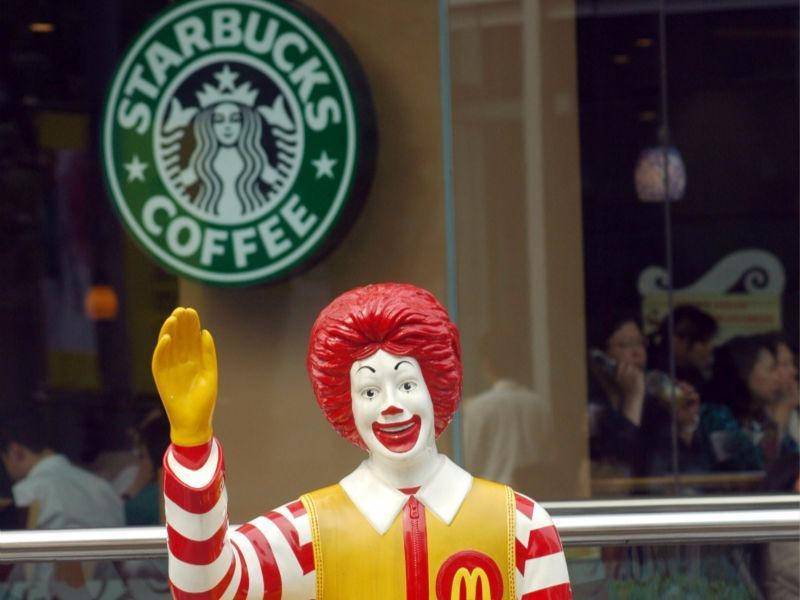
Howard Schultz, the former CEO of Starbucks, the world's number one coffee chain, has resigned and has been replaced by Kevin Johnson, the company's former chief operating officer, according to a recent report by Huali Zhi. (for more information, see the related report in Huali Zhi: the new CEO talks about the future of Starbucks: I will not be the next Howard Schultz)
As the soul of Starbucks for a long time, Howard Schultz has previously made a five-year plan to open 10, 000 more stores in five years to become a coffee chain brand that makes all customers satisfied. Bring the company into its heyday, but it is also faced with more severe challenges.
(for more information, see the report in Huali Zhi: Schultz warns: traditional retail is going to experience a great recession! Then why does Starbucks open 12000 new stores? )

Image above: Howard Schultz (left) and Kevin Johnson (right)
In recent years, Starbucks has suffered a double-sided attack in the coffee chain industry:
On the one hand, fast food brands such as Dunkin' Donuts and McDonald's have taken away many customers with low-cost coffee.
On the other hand, Intelligentsia and Blue Bottle emerged in the boutique coffee wave (the third coffee wave). Baristas have attracted high-end customers with their superb skills.
If Starbucks is to be invincible in this diversified market competition, it needs to think about more practical questions:
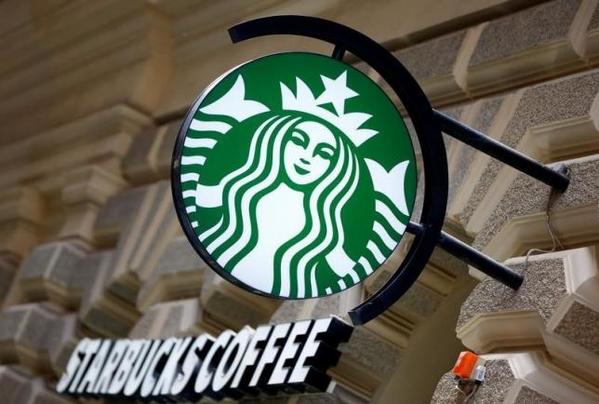
The controversial cup shape
When the first Starbucks opened in New York, many Americans didn't even know what a "latte" was. The New York Times wrote about what a latte is and its Italian pronunciation.
The emergence and popularity of Starbucks has brought a different coffee culture and a series of innovative products to American customers, from which it has made billions of dollars in profits. A typical example is the coffee cup type of Starbucks.
Inspired by the Italian coffee culture, Howard Schultz introduced the concepts of grade and venti.
Craig Gathwaite, an associate professor of strategic studies at the Kellogg School of Management at Northwestern University, believes that the cup is a miniature strategy for Starbucks to provide a macro luxury experience. For example, some customers can't afford to buy a BMW, but he can drink a "large" or "super-large" Starbucks coffee, which is more expensive than a regular cup, which is also a small luxury experience. With the continuous expansion of Starbucks, the names of tall, grande and venti have gradually replaced the traditional large and medium cups.

In 2004, an author named Dave Barry published a critique of the Starbucks Cup in the Times. He pointed out in the article, "Starbucks called the actual small cup 'medium cup', so customers were fooled and seriously followed the term 'medium cup'." The original text is as follows:
Starbucks decided to call its cup sizes "Tall" (meaning "not tall," or "small"), "Grande" (meaning "medium") and "Venti" (meaning, for all we know, "weasel snot"). Unfortunately, we consumers, like moron sheep, started actually USING these names. Why? If Starbucks decided to call its toilets "AquaSwooshies," would we go along with THAT?
In 2006, rival Dunkin' Donuts produced a mocking advertisement attacking Starbucks for mixing Italian and French on menus and cups. But this reflects from the side that Starbucks really created a coffee drink as a soft drink in that decade. Lattes have become synonymous with the elite, and not all ordinary Americans can afford it.
In 2008, Dunkin' Donuts began selling drinks similar to Starbucks, but at a much cheaper price and completely preserving the brand's American culture.
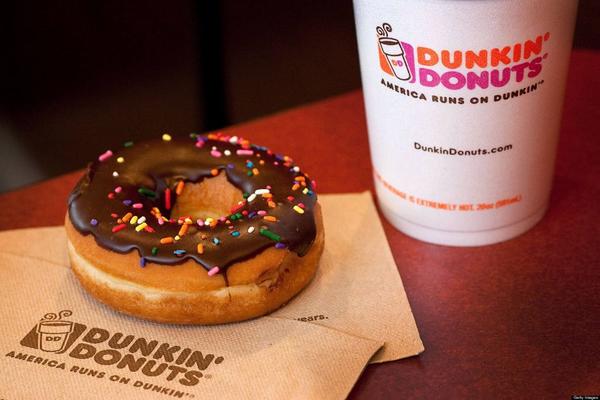
Howard Schultz believes that the integration of some Italian culture is Starbucks' strategy to reflect the uniqueness of the brand. Bryant Simon, an American scholar, wrote in his book Everything But the Coffee: "customers believe that their Starbucks large lattes reflect their personality and taste, even if they are willing to spend more money."
Starbucks' strategy is different from McDonald's and Dunkin' Donuts's low-price, fast-food strategy, but focuses on creating a romantic experience atmosphere. But when similar problems such as cup events become common, Starbucks may face difficulties.
Expand too fast
In the 1970s and 1980s, Starbucks was remembered first as a coffee roaster and second as a coffee chain.
After Howard Schultz joined Starbucks in the early 1980s, he firmly believed that the company could expand rapidly while maintaining a high positioning. Howard Schultz left the company in the mid-1980s because he was at odds with the founder of Starbucks (who failed to convince him that the company could become a global chain brand). It wasn't until 1987, when he bought a controlling stake in Starbucks and 17 stores from its founder, that he began his expansion plan.
Between 1998 and 2008, the number of Starbucks coffee shops increased from 1886 to 16680. Starbucks' goal is to become the third destination between the customer's office and home. Ambitious expansion plans have met with a lot of irony.
In 1996, Starbucks had only 700 stores. The American NPR radio program "All Things Considered" announced in April that "Starbucks wants to build a coffee pulp pipeline (transcontinental coffee slurry pipeline) across the continent."
In 2000, Onion, an American satirical news site, had a satirical headline that "Starbucks opened a New Starbucks Opens In Rest Room Of Existing Starbucks in its own bathroom".
In the same year, an episode of the famous American animated series "the Simpsons" showed the protagonist Bart walking into a shopping mall and looking up to find that the sign of each store was Starbucks.
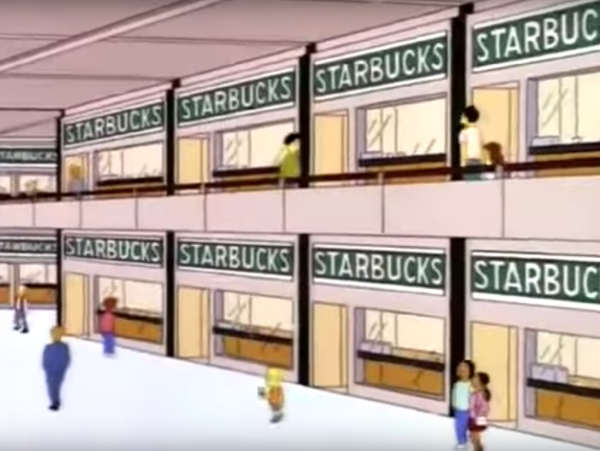
These funny jokes reflect the potential problems of Starbucks from one side. The new CEO Kevin Johnson said in a recent interview with the US website Business Insider that the growth rate of the new store has exceeded the number of employees the store can serve. For the sake of expansion and shareholder return, the company has abandoned regular staff training and a strategy aimed at the high-end market. (for details, see the report in Huazhi: Starbucks'US store trading volume has declined, its full-year forecast has been lowered, and the surge in mobile phone orders has led to operational problems.)
In order to improve operational efficiency, stores began to use high-end automatic Italian espresso machine La Marzocco, followed by a decline in the quality of coffee, with a "fast food" flavor.
In his book Onward, Howard Schultz acknowledges that crises usually come slowly and quietly, but have a subtle knock-on effect. He resigned as CEO in 2000, but remained a member of the company's board of directors.
At this time, competitors such as McDonald's sensed the opportunity and launched similar coffee drinks such as low-cost lattes. More and more people are asking themselves, "Why should I spend $4 on a cup of coffee?" Starbucks, as a coffee chain giant, began to go through a recession and finally hit bottom in 2008.
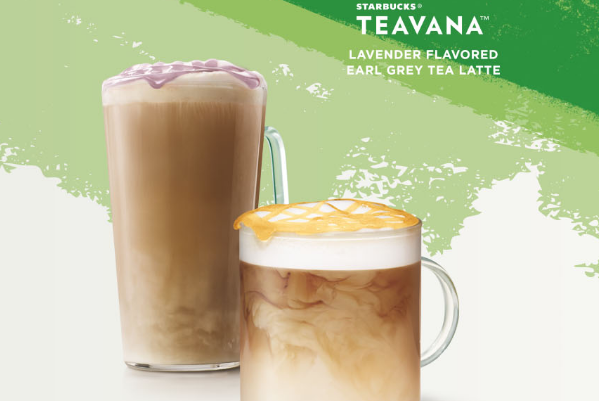
In January of the same year, Howard Schultz returned to take on the task of rekindling customer enthusiasm for Starbucks.
In February, he announced that all 7100 stores in the United States would be closed within 3.5 hours to retrain baristas on how to make high-quality espresso.
In July, Starbucks closed 600 underperforming stores.
Under the leadership of Howard Schultz, Starbucks stores began to return to their brand roots, replacing espresso machines and renovating them with designs appropriate to the local style, making them more "cafe-like". Starbucks shares have risen more than 1140% since the end of 2008, adding 10,000 stores worldwide.
In fact, since then, Starbucks has not returned to the high-end positioning of the 1990s, and the brand has entered an era of attracting consumers from all walks of life. The positioning of the mid-market has precisely become an incentive for Starbucks to get caught in the "double-sided attack". In the years that followed, Starbucks shares stagnated again, and store passenger growth began to slow one after another.
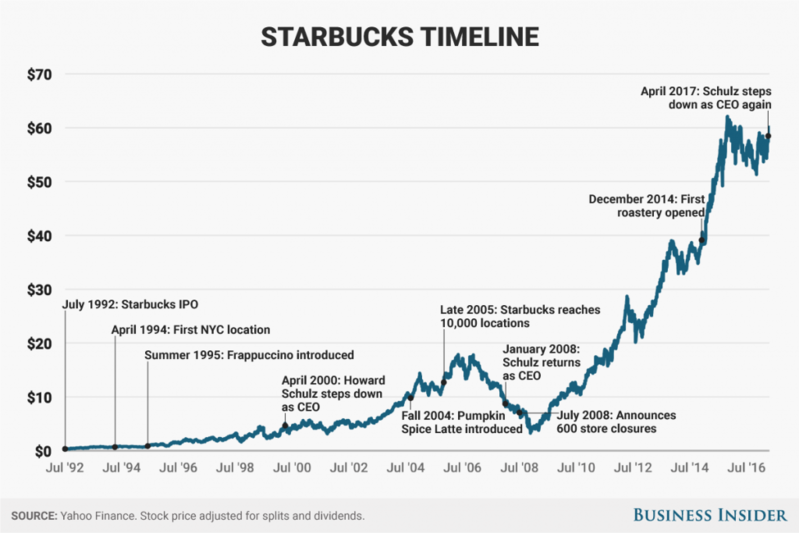
Image above: stock price trend since Starbucks went public in July 1992
The joys and sorrows of online celebrity drinks
If you use a drink to describe the current situation of Starbucks, the most suitable is Starbucks' traditional seasonal drink pumpkin latte (Pumpkin Spice Latte) every autumn.
Since its launch in 2003, pumpkin lattes (pictured below) have sold 200 million cups, and even have dedicated Twitter accounts. Pumpkin lattes have become popular on American social networks, peaking in 2014 when pumpkin lattes have become synonymous with all kinds of "must-have xxx" on the Internet.
This is mixed news for Starbucks: on the one hand, it has undoubtedly boosted sales of pumpkin lattes, which the company expects to reach $1 billion; on the other hand, after becoming an "online celebrity" drink, Starbucks's brand image is moving further and further away from high-end positioning.

After that, Starbucks began to look for change. In 2014, Starbucks opened the world's first flagship coffee roasting store, Roastery (below) in Seattle, combining coffee making, menu tasting and ingenious architectural design. This laid the foundation for Starbucks to launch the high-end coffee roaster brand Reserve.
Kevin Johnson said that Starbucks will avoid the trend of commercialization in the process of rapid growth, and that the company's important strategy is to enhance its brand, which is why it launched Roastery. 1000 Reserve stores around the world will adopt the Roastery Bakery experience model and produce delicious food on site. In the future, 20 per cent of Starbucks stores will be equipped with Reserve bars to meet the need to mix a wider variety of drinks.
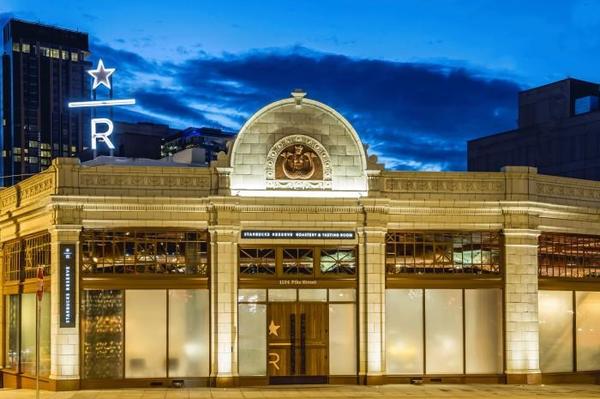
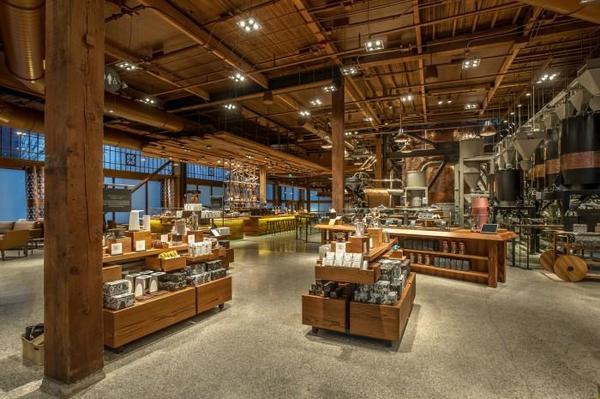
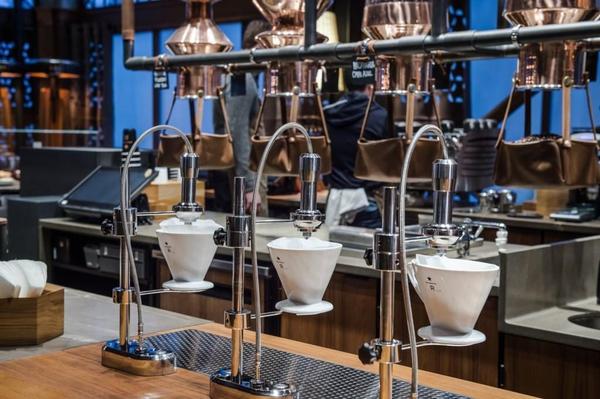
In April, Starbucks opened its third Roastery bakery in the United States in Chicago and launched a topical drink like a pumpkin latte, Unicorn Frappuccino.
This drink is once again popular on the Internet because of its gorgeous colors and sweet and sour taste. When you stir the unicorn star cappuccino, the color of the drink changes wonderfully and immediately becomes a hot drink on Instagram, with countless photos uploaded by customers advertising Starbucks for free (below).
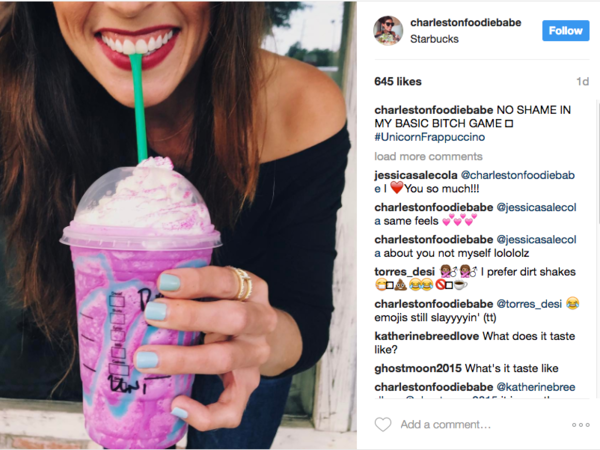
The diversification of customer base
In addition to the above-mentioned roasting experience shop, which represents the model of boutique coffee, in April this year, Starbucks opened a pilot mobile phone order exclusive restaurant in its headquarters in Seattle, where customers rushed in to pick up the coffee ordered by their mobile phones and hurried out, while baristas made coffee non-stop.
The two store models form a sharp contrast, but in fact, the two stores are only a few miles away.
Looking back at the history of Starbucks, we can clearly see that the company's brand positioning is constantly changing, precisely according to the needs of customers (some for experience, some for convenience and efficiency). Maintain this delicate balance.

The launch of Roastery and Reserve stores is designed to prove to Starbucks mockers that the company is no less innovative than it was in the 1990s. Last October, Howard Schultz said Roastery provided Starbucks with a good opportunity to return to the "ultra-high-end" brand. In the face of the constant threat of e-commerce and mobile shopping, Starbucks' brick-and-mortar stores should focus on creating an atmosphere and experience environment.
According to Kevin Johnson, the main reason why people rarely joke that "Starbucks is going to open a store in its own bathroom" in recent years is that Starbucks stores are very different from what they used to be, combining a variety of business models:
Convenient and winning mobile phone to place orders in exclusive stores
Regular Starbucks stores
Starbucks Shuttle Restaurant
Bakeries like Roastery and Reserve
What all these models have in common is to highlight customer service and compete with different types of competitors (fast food chains or high-end coffee chains).
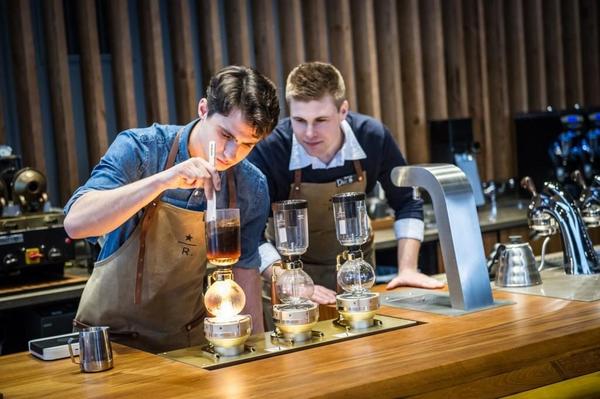
But there are still people who believe that Starbucks can't meet the needs of all its customers (everything to everyone). Some people come in just for a cup of coffee, while others use coffee as a work of art. How does Starbucks, which is oriented to the needs of the public, solve the difficult problem?
The video "who drinks Starbucks (Types of People at Starbucks)" recorded by American anchor Bethany Mota has recently attracted more than 1.5 million views on YouTube. In her video, there are people who come to drink Starbucks for the "hidden menu", some for taking pictures and posting on social networks, and some rude guests.
In the face of such a diverse customer base, will Starbucks be questioned again in the future: who will pay $10 for a low-fat drink?
? source of information: us website Business Insider
? photo Source: Starbucks website, US website Business Insider, Instagram
Important Notice :
前街咖啡 FrontStreet Coffee has moved to new addredd:
FrontStreet Coffee Address: 315,Donghua East Road,GuangZhou
Tel:020 38364473
- Prev

The smiling hope of the ancient city of Quanzhou: the shopkeeper of the coffee inn in the garden (photo)
Smile Wall, one of the smile planners of the ancient city, will be on display at Suqimen Square on West Street on April 28 and will last for a week. Readers who submit photos to this newspaper, remember to find yourself. Passing friends, can also take a picture with the smiling face wall, leaving a beautiful memory of the ancient city. Hu Wang wants to take his daughter to travel together. At the age of 17, she started backpacking and started traveling alone. Hu, a girl from Hunan,
- Next
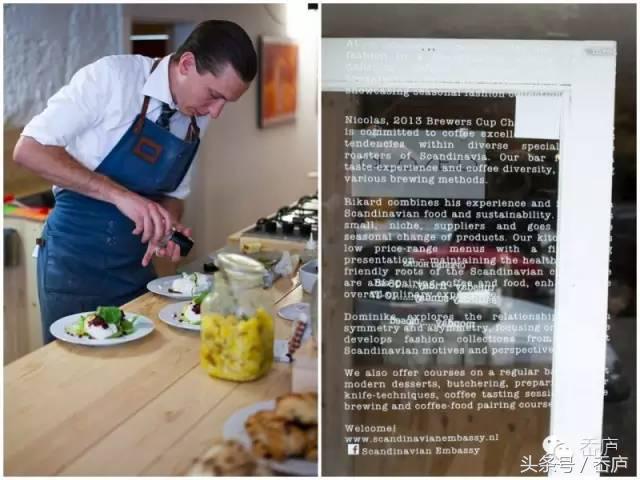
Coffee with oysters, salad into cake. There are so many creative delicacies hidden in the cafe!
A cafe is not only a place to sell coffee, but also a way of life, an expression of good things. There should be up-to-date food information, correct flavor presentation and excellent taste experience. ▼ Holland | Scandinavian Embassy Michelin-level cafe Nicholas is proficient in coffee production and won the Swedish brewing championship in 2013; while Rikard
Related
- What documents do you need to go through to open a coffee shop? coffee shop coffee shop certificate processing process
- How to purchase Coffee beans in small Cafe how to choose a suitable supplier for domestic Coffee supply Company
- How to drink Starbucks Fragrance White Coffee? how to make Australian White Coffee? what Italian coffee beans are recommended?
- The Story of Flora Coffee: the name of Flora Coffee Bean and the implication of the Flowers on Florna Coffee
- How much does a cup of coffee cost? How much is the profit of a cup of coffee? What is the profit of the coffee shop in a year?
- Yunnan small Coffee, known as "fragrant Coffee", introduces the characteristics of Alpine Arabica Coffee producing areas in Yunnan, China
- 2023 latest Starbucks full menu price list how much is a cup of Starbucks coffee what is better to drink the most popular hot and cold drinks recommended
- Starbucks different kinds of Coffee Price list Starbucks menu 2023 Top Ten Best drinks in Starbucks
- Starbucks Spring praise Comprehensive matching Coffee Bean theme Story Packaging implication and taste description
- The cost of a cup of coffee latte American coffee cost price and selling price

